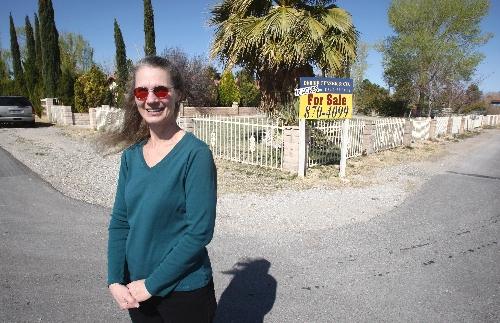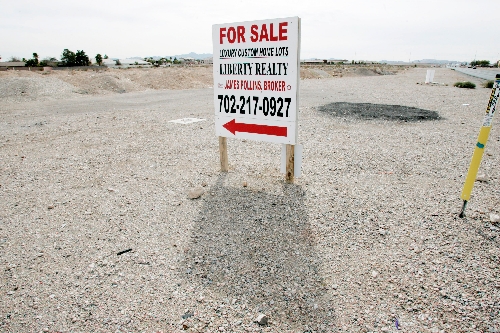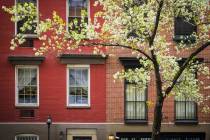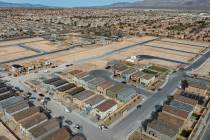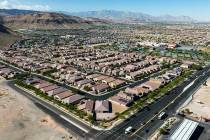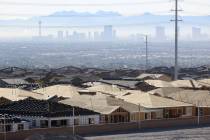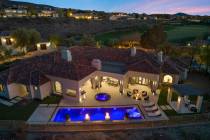Recession leaves raw land in dust
Fortunes have been made and lost on land deals in Las Vegas.
Mostly lost, lately.
Take, for example, Elad Group, a New York-based company controlled by Israeli billionaire Yitzhak Tshuva. It paid $1.24 billion, roughly $36 million an acre, for the New Frontier in 2007. It was the highest price ever fetched for Strip property, topping Turnberry's $30 million an acre for the former Algiers hotel site.
There it sits today, barren desert, except for the Trump International condominium-hotel that closed escrow on about 20 percent of its $1,000-a-square-foot luxury units.
What's the land worth today? Hard to tell when there are no buyers.
Elad isn't alone. Focus Property Group bought 5,000 acres for development of Mountain's Edge, Providence, Inspirada and Kyle Canyon master-planned communities, only to go into default in 2008 on a $470 million loan with Wachovia Bank.
Triple Five Development defaulted on a $27 million loan with Keybank National last year for land in the northwest once planned for the Great Mall of Las Vegas.
Across the valley, smaller parcels that were purchased by private groups for development or investment purposes before the "Great Recession" have gone back to the bank. About half of commercial mortgage defaults in Las Vegas last year were for vacant land.
Bruce Hendrick, chief executive officer of Nevada State Bank, said the local bank has never been a big lender for vacant land, though he's done a few deals in the last couple of quarters for both residential and commercial land.
"We're going to look at current development plans," Hendrick said. "We're not going to lend for speculative purposes. That's not our niche. Our focus is on owner-occupied real estate. In addition to development, we want a strong equity value, a strong loan-to-value based on today's appraised value."
Prices for raw, or undeveloped, land in Las Vegas have fallen 74 percent from their peak of $939,357 an acre in fourth quarter 2007, business advisory firm Applied Analysis reports.
Excluding the resort corridor, the average price dropped to $243,368 an acre, or $5.59 a square foot, in the fourth quarter, down 37.9 percent from a year ago, Applied Analysis reported.
The slide is starting to level off. Prices fell 50.8 percent in the third quarter compared with the year-ago period and 58.3 percent in fourth quarter 2008. Also, the fourth-quarter average is up from $225,999 in the third quarter, the firm reported.
Debbie Cenzer, a land agent in Las Vegas for 25 years, said she reads various reports about raw land prices, but they're "commingled" with residential and commercial uses. The average price for a half-acre rural residential lot can't be compared to the average for a 12-acre parcel on Harmon Avenue and the Strip, she said.
The number reported by Applied Analysis is too high, Cenzer said. She has a 2.5-acre parcel near Torrey Pines and Russell Road that was bought for $1.3 million, put back on the market by the lender at $650,000, reduced to $450,000 and is now being offered for $189,000.
"I couldn't get $290,000 if you put a gun to my head," she said.
Sales volume, while far below peak levels, increased for the third consecutive quarter, Applied Analysis reported. There were 349 parcels sold in the fourth quarter totaling 468 acres, compared with 248 parcels and 410 acres in the previous quarter.
Nearly two-thirds of those transactions were distressed sales or trustee deed transfers with lenders, Applied Analysis principal Brian Gordon noted.
"For land speculators today, what's the exit strategy? Their ability to build out is limited by upside potential," Gordon said. "The commercial end continues to struggle and we're seeing construction activity essentially coming to a halt, so you have less demand for real estate for commercial today, whereas residential land has been turning over in anticipation of the bottom."
Builders have become more active in acquiring land, especially those who didn't go out and buy five years of lot inventory, housing analyst Dennis Smith of Las Vegas-based Home Builders Research said. They're now taking advantage of low prices.
"The land market today is different than the past for residential land," Smith said. "The only land that has been selling for the last year is finished lots ready to go vertical. Lots that were selling for $25,000 are now $35,000 and we're seeing a little more demand."
With the median new-home price around $200,000, builders can't afford to build on lots bought in 2006, Smith said. They have to let that land sit and go after distressed lots for $25,000, he said.
Richmond American and Harmony Homes are among local builders buying land. Harmony bought two parcels in Lake Las Vegas from Pardee Homes in December.
With builders underwriting to smaller net margins and projecting flat to minimal price appreciation, buyers are targeting finished lot-to-home ratios as high as 30 percent in the most attractive locations and 10 percent to 15 percent in fringe areas, real estate consultant Marta Borsanyi of Newport Beach, Calif.-based Concord Group said.
Given the abundance of now-available home inventory, demand for "paper lots," or those that still need improvement, is minimal, she said.
That's left land speculators who counted on continued growth in Las Vegas' new-home market holding the bag in many cases. STGG Holdings defaulted on eight separate loans in February, a total of $36.7 million, for nearly 42 acres of raw residential land near Tule Springs Park, according to a report from Nevada Title Co.
Clark County assessor records show the parcels were purchased for much less than the loan amounts. For example, a 4.27-acre parcel that sold for $1.75 million in May 2005 was financed for $10.6 million, and a 2.1-acre parcel bought for $880,000 was financed for $1.3 million. Officials with Windemere Capital, the Las Vegas hard-money lender that originated the loans, would not comment on land financing strategies.
Cenzer said most people don't understand what it takes to develop a property. She's got 10 acres for sale in northwest Las Vegas with a large single-family home, two wells, koi pond, pool and spa and four-horse stall. The price has been reduced from $3 million to $2.3 million.
"You can't find a 10-acre lot in Las Vegas," Cenzer said. "A lot of horse people have moved out of the valley as builders encroached on their territory. All of those tract homes came in and riders lost their trails, so they went to Kyle Canyon, and when that got targeted, they moved to the perimeters."
Applied Analysis' Gordon said excess capacity in existing buildings is the overriding factor reducing demand for raw land. With 30 million square feet of vacant commercial space and excess inventory of 35,000 homes in the valley, speculation remains the primary motivation for anyone to acquire undeveloped property, he said.
Some investors see opportunity to make money in the down market. A 62.6-acre parcel at Interstate 15 and Russell Road, behind Mandalay Bay, sold for $40 million, or $639,182 an acre, in the fourth quarter.
As with any potential investment, prices will be a determining factor and the downward trend in prices is not expected to reverse course anytime soon, Gordon said. Anyone who acquires raw land today should adjust the price to account for a three- to five-year holding period.
Colliers International land broker Scott Gragson said most investors feel Las Vegas is a great place for long-term investment on the commercial side. He's seen more activity in the last two months than in the last two years.
"I think you can (make money) if you're very patient and definitely getting a strategic location and great prices," he said. "People are paying all cash. This is like residential. Banks want to get it off their books and prices will portray that."
Lenders are dictating prices, but their "hands are tied" by the Federal Deposit Insurance Corp., Gragson said. Although location still factors into pricing, it's more about holding costs today, he said.
"The market dictates the final price, but the lender might have 10 properties in 10 locations. Who wants to get it off the books, when and where," Gragson said. "It's just unfortunate that everyone can't get together in one room and find a solution and that solution is time."
There are high net worth individuals in Las Vegas who would become a "player" at a certain number, but that number has to be pretty low, Gragson said.
Roughly 85 percent of Nevada's undeveloped land is owned by the U.S. Department of Interior and managed by the Bureau of Land Management. The Southern Nevada Public Lands Management Act of 1998 authorized the bureau to sell 27,000 acres in Las Vegas Valley at auctions twice a year for fair market value.
The first large sale of 2,000 acres in North Las Vegas fetched about $40,000 an acre from a joint venture between American Nevada Co. and Del Webb Corp. Within a few years, developers such as Focus Property Group and Olympia Group had driven prices up to $250,000 an acre.
It was a surreal scene at those auctions when bids were being raised $1 million at a time. Then a strange thing happened. The BLM held an auction and bidders went silent. They complained that BLM appraisers were out of touch with market reality in setting minimum bids.
That pretty much symbolized the crash in Las Vegas real estate, pulling the rug from underneath land speculators and investors.
Not many land deals are getting done and those few deals are at a discount, Focus Property Chief Executive Officer John Ritter said.
"There's money on the sidelines, but it ain't jumping in," Ritter told the Review-Journal last year. "Nobody wants to catch the falling knife. People who did jump in, their stuff went down in value, so now they're gun-shy."
Contact reporter Hubble Smith at hsmith@reviewjournal.com or 702-383-0491.



